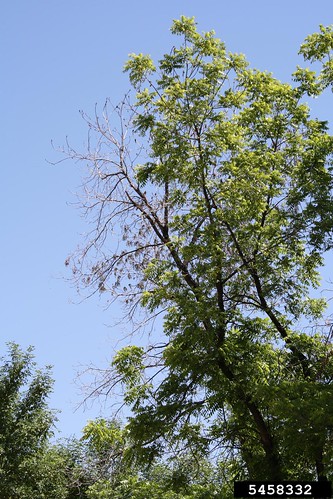Thousand Cankers puts black walnuts in peril
Symptoms of Thousand Cankers Disease. (Image by Karen Snover-Clift, Cornell University, Bugwood.org)
Fast facts
- April is Invasive Plant Pest and Disease Awareness Month
- Visit http://www.arinvasives.org/ to learn to ID threats
- Thousand Cankers threatens black walnuts, has been spotted in eastern Tennessee
(374 words)
LITTLE ROCK -- A beetle the size of the period at the end of this sentence is proving to be the biggest smuggler of a major threat to the nation’s eastern black walnut trees.
Black walnuts are prized for their unique flavor and are used in pies and other pastries and Native Americans used the hulls for digestive health.
The culprit is the walnut twig beetle, who carries the spores of the fungus that causes Thousand Cankers Disease. The disease is somewhat unique in that it is native to the western United States, but now that it has spread eastward, courtesy the tiny beetle, and attacks black walnuts, which have no resistance.
“We’ve seen invasive species nearly cause the extinction of valuable native American tree species such as elm and chestnut. Historically, both have been economically important trees in the U.S.,” said Tamara Walkingstick, associate director of the Arkansas Forest Resource Center of the University of Arkansas System Division of Agriculture.
Sadly, there’s no reliable way to control Thousand Cankers Disease, but humans can prevent further spread by not moving firewood or unprocessed black walnut wood or nursery stock from or into restricted areas. Recommendations are for infested trees to be cut down and burned on site, or if burning is not possible, then the tree should be cut down and left to decompose on site.
The cankers expand and girdle infected trees, disrupting flow of water and nutrients. The leaves will turn yellow, wilt and turn brown. Branches will die and the whole tree will succumb about three years after the first symptoms of decline show.
Thousand Cankers has been found in eastern Tennessee, Virginia and Pennsylvania.
Extension Forester Jon Barry said it’s important for the public to know how to identify invasive species and understand how these non-native pests spread.
“We have the http://www.arinvasives.org/ web site designed to provide information about ID and control of forest invasive pests,” he said. “We encourage people to plant native ornamental plants, or at least make sure that what they plant is not invasive.”
Arkansans are also being encouraged to “to report possible sightings of invasive pests to the Cooperative Extension Service or State Plant Board or the federal Animal and Plant Health Inspection Service, or APHIS,” he said
To learn more about thousand cankers disease, visit www.thousandcankers.com/.
For more information about invasive species in Arkansas, visit http://www.arinvasives.org/, our newly revamped site at www.uaex.uada.edu, or contact your county extension office.
Pursuant to 7 CFR § 15.3, the University of Arkansas System Division of Agriculture offers all its Extension and Research programs and services (including employment) without regard to race, color, sex, national origin, religion, age, disability, marital or veteran status, genetic information, sexual preference, pregnancy or any other legally protected status, and is an equal opportunity institution.
By Mary Hightower
The Cooperative Extension Service
U of A System Division of Agriculture
Media Contact: Mary Hightower
Dir. of Communication Services
U of A Division of Agriculture
Cooperative Extension Service
(501) 671-2126
mhightower@uada.edu
Related Links
